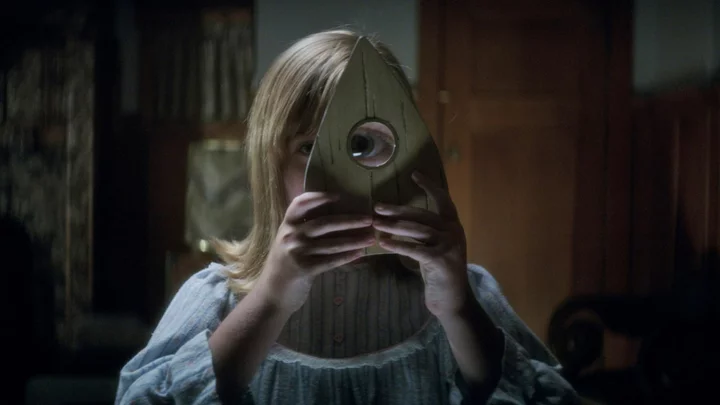Mike Flanagan has brought a flood of freaky TV series to Netflix, from The Haunting of Hill House and The Haunting of Bly Manor to Midnight Mass and The Midnight Club. But with The Fall of the House of Usher, he manages to slyly fold in references not only to all things Edgar Allan Poe, but also to his frightening feature films, including Gerald's Game and Hush.
Some are easier to spot than others, either because Netflix can't stop referring to its own catalog (see also Black Mirror) or because some fashion choices were made to stand out. But this creepy bit of background dressing is definitely of the blink-and-you'll-miss-it variety. Early on in Usher, Flanagan works in a prop that's a callback to his time before his prolific Netflix run, when he directed a surprisingly effective prequel that wickedly outshined its predecessor: Ouija: Origin of Evil.
What is Ouija: Origin of Evil?
In 2014, Universal Pictures and Blumhouse Productions joined forces to turn the Ouija board game into a franchise, hoping to follow the success of Insidious and Paranormal Activity. Tons of scary stories have spawned from this spirit board and its iconic planchet. Yet with Ouija, director Stiles White turned in a frustratingly bland tale of teens terrorized by ghosts.
Critics hated the movie. Right now it sits with a ghastly Rotten Tomatoes score of just 5%. (Audiences weren't much more forgiving, offering a 24% rating.) But hey, terrible or not, Ouija scared up more than 10 times its budget at the box office. With a return on investment like that, a sequel was inevitable. Thankfully, the producers brought on Mike Flanagan.
The horror filmmaker was on a winning streak, having created such critically acclaimed scary movies as the tunnel-set thriller Absentia and the mirror-focused menace Oculus. For Ouija: Origin of Evil, Flanagan and his Oculus co-writer Jeff Howard decided to look back instead of forward, penning a prequel that tapped into the spooky lore presented in the 2014 movie.
Set in 1967, Ouija: Origin of Evil taps into a common setting for Flanagan frights: a family devoted to each other but strained by the influence of malevolent paranormal forces. In this instance, Alice Zander (Elizabeth Reaser) is a widowed mother of two who does psychic readings to put food on the table. Her daughters, teen Lina (Annalise Basso) and nine-year-old Doris (Lulu Wilson) help out, as their mother's seances are a series of ruse and tricks. That is, until they decide to bring an Ouija board in as part of their schtick.
Seeking to reconnect with her dead dad, Doris uses the board on her own — unlocking a connection to evil entities she cannot begin to understand. Horror ensues, along with the kind of jump scares that truly deserve that description.
SEE ALSO: Where you've seen 'The House of Usher' cast before: Welcome to the FlanaverseHow is Ouija: Origin of Evil referenced in The Fall of the House of Usher?
Roderick Usher (Bruce Greenwood) spins a tale in "A Midnight Dreary." Credit: NetflixIn episode 1, "A Midnight Dreary," Roderick Usher (Bruce Greenwood) tells his nemesis C. Auguste Dupin (Carl Lumbly) the chilling story of his mother's death and resurrection.
"Pain and suffering are like the kiss of Jesus," Eliza (Annabeth Gish) tells young Roderick. "If pain and suffering were the kisses of Jesus, then he kissed the living fuck out of my mother in the years that followed," a rueful Roderick recalls in voiceover. In 1962, Eliza becomes dreadfully ill but refuses all medical intervention, declaring, "Jesus showed us how to heal the sick, and it wasn't through medicine!" Eliza dies at home soon after that. From there, her teen children dutifully bury her body in the backyard, eschewing a formal burial and embalming — the latter of which would be against her wishes, as she believed they'd be against God's.
That night, Roderick (Graham Verchere) and his sister Madeline (Ouija: Origin of Evil's Lulu Wilson) share a bed. At the 14:48 mark, before they are awakened by their mother's grisly rise from her homemade grave, we see a curious toy beside their bed. Next to books and games, upright against some shelves leans an Ouija board. In the dark room, the black game board with gold lettering might be missed were it not for the flash of lighting sputtering outside. But its presence seems strange in the Usher home.
The Usher children lie in bed next to a Ouija board. Credit: Screenshot Netflix.Eliza Usher's faith demanded that she not offend God by putting outside elements into her body, even medicine. (She sure would have hated that her children made a fortune and a literal killing in the Fortunado drug company). We can reasonably assume this deeply Christian woman who speaks of Jesus like an abusive husband wouldn't have allowed this controversial board game in her home, as it (unfairly or not) has long held a reputation for being a portal to the demonic.
So, what is the Ouija board doing in the Usher home? Perhaps it was something the twins had intended to use to talk to her in a scene later left on the cutting room floor. Perhaps it was a bit of teenage rebellion that no longer needed to be hidden as they thought their mother was dead. But most likely, this was Flanagan connecting The Fall of the House of Usher to another truly scary tale of a single mother and her two children, afflicted by the banal evil of poverty and a supernatural force that would gladly treat them like playthings.
Plus, like the Hush mask in episode 2, this creepy callback to Flanagan's past signals his fans that something horrific is about to go down. In this case, the board that lets you speak to the dead is a sign to us that Roderick and Madeline will have another chance to commune with their dearly departed mom. Though, like in Ouija: Origin of Evil, you really ought to be careful what you wish for when it comes to the dead.
How to watch: The Fall of the House of Usher is now streaming on Netflix.
How to watch: Ouija: Origin of Evil is now streaming on Netflix.









